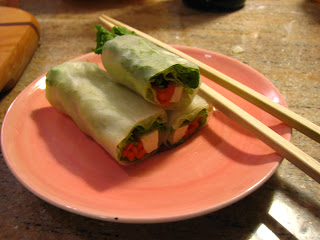A month ago
Matt and I started on an anti-inflammatory diet in the hope we’d be able to
relieve his CFS symptoms nutritionally. The diet eliminates refined sugars of
all kind. Much of the sugar’s we’ve been consuming come from root vegetables
and fruit alone. I’ve decided to pick up the mixing bowl for the first time
with this sugar restriction... what I came up with is a deliciously moist, healthy,
gluten-free, lactose and casein-free, sugar-free recipe for chocolate cup
cakes.
Nutritional
content: Approx 130 calories per cupcake (with icing), they are good source of
Vitamin A and very good source of anti-oxidant, Manganese with only 3 grams of
sugar per cake.
For the Cake
6
tablespoons brown rice flour
1
tablespoon potato starch
1
tablespoon gluttonous rice flour (sweet rice)
1 teaspoon xanthium gum (optional, provides a better texture)
2
tablespoons of cocoa powder (unsweetened)
1 teaspoon aluminum free baking powder
1 teaspoon
apple cider vinegar (or white vinegar)
1 teaspoon
bicarbonate of soda (baking soda)
2
tablespoons organic ghee (clarified butter)
1½ tablespoon of walnut oil
1½ teaspoon of vanilla extract
2
tablespoons agave nectar (or honey)
10 drops
liquid stevia
2 free
range eggs
½ cup raw
beets (finely grated or food processed)
½ cup of
raw finely grated carrot (1 medium carrot)
¾ cup filtered water (or as needed)
Vegan Chocolate Icing
¾ cups of soy powder (available in
natural/organic food stores)
2 tablespoons of cocoa powder (unsweetened)
2 tablespoons of coconut oil (or vegetable
spread)
5 drops of stevia
1 tablespoon agave nectar
2 drops vanilla extract
Water as needed
A small handful of raw cocoa nibs to decorate
(optional)
Notes about
the ingredients: I use organic ingredients where possible. I feel this is a
necessity for ghee and eggs as organic free range produce has better nutritional
content (i.e more omega-3 oils). Ghee is
virtually lactose and casein free due to the milk solids being removed from the
butter. It is a great alternative to butter for those with
dairy allergies, if you cannot find ghee it is easy to make. The beets and carrots are required to provide sweetness and more importantly, structure in the cake where sugar is not present. Agave is a low glycemic index alternative fructose sweetener and is a common raw vegan substitute for sugar and honey. Stevia is a herb with very sweet tasting leaves. It's a natural, calorie-free sweetener which can be purchased in powdered or liquid form, we prefer the liquid in this kitchen!
Pre-heat
the oven to 350°F, and ready the muffin tin with cupcake
cases. Start by mixing the ghee and oil until well blended. Stir in the stevia drops, agave and vanilla
extract. Sift in the cocoa powder, add the processed beets, carrots, eggs and
mix very well. Next, sift in the flours including the baking powder (reserve
the baking soda for later). After combining, add the water slowly to create a more
fluid batter. Lastly, in a separate bowl, pour the apple cider vinegar with the
baking soda so that it fizzes up. Carefully fold this into the cake mix making
sure not to stir too much. When ready, spoon the batter into the baking tin.
Bake for 12 to 14 minutes. Leave out on wire racks to cool.
For the icing, mix the coconut oil well until
smooth, add the vanilla extract, stevia and sifted cocoa powder mix in the soy
powder and slowly add water until a desired consistency is reached. Use when
cakes have cooled and finish with cocoa nibs.
 Nutritional
Content: Per serving (250g) there are 347 calories. This smoothie set’s you up
with wholesome carbs, protein as well as high amounts of vitamin A, manganese
and dietary fiber for the day.
Nutritional
Content: Per serving (250g) there are 347 calories. This smoothie set’s you up
with wholesome carbs, protein as well as high amounts of vitamin A, manganese
and dietary fiber for the day.














